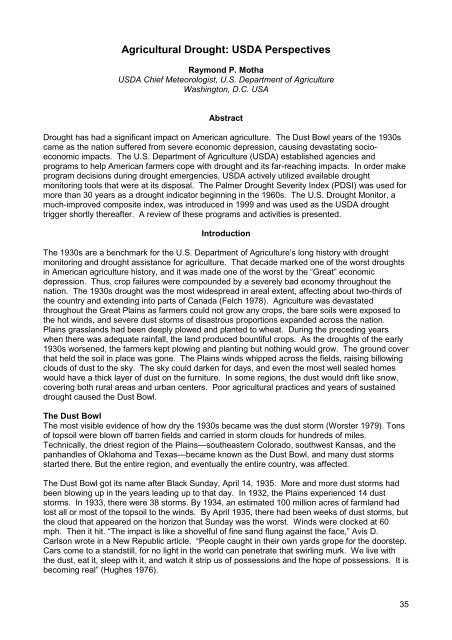Agricultural Drought Indices - US Department of Agriculture
Agricultural Drought Indices - US Department of Agriculture
Agricultural Drought Indices - US Department of Agriculture
You also want an ePaper? Increase the reach of your titles
YUMPU automatically turns print PDFs into web optimized ePapers that Google loves.
<strong>Agricultural</strong> <strong>Drought</strong>: <strong>US</strong>DA Perspectives<br />
Raymond P. Motha<br />
<strong>US</strong>DA Chief Meteorologist, U.S. <strong>Department</strong> <strong>of</strong> <strong>Agriculture</strong><br />
Washington, D.C. <strong>US</strong>A<br />
Abstract<br />
<strong>Drought</strong> has had a significant impact on American agriculture. The Dust Bowl years <strong>of</strong> the 1930s<br />
came as the nation suffered from severe economic depression, causing devastating socioeconomic<br />
impacts. The U.S. <strong>Department</strong> <strong>of</strong> <strong>Agriculture</strong> (<strong>US</strong>DA) established agencies and<br />
programs to help American farmers cope with drought and its far-reaching impacts. In order make<br />
program decisions during drought emergencies, <strong>US</strong>DA actively utilized available drought<br />
monitoring tools that were at its disposal. The Palmer <strong>Drought</strong> Severity Index (PDSI) was used for<br />
more than 30 years as a drought indicator beginning in the 1960s. The U.S. <strong>Drought</strong> Monitor, a<br />
much-improved composite index, was introduced in 1999 and was used as the <strong>US</strong>DA drought<br />
trigger shortly thereafter. A review <strong>of</strong> these programs and activities is presented.<br />
Introduction<br />
The 1930s are a benchmark for the U.S. <strong>Department</strong> <strong>of</strong> <strong>Agriculture</strong>’s long history with drought<br />
monitoring and drought assistance for agriculture. That decade marked one <strong>of</strong> the worst droughts<br />
in American agriculture history, and it was made one <strong>of</strong> the worst by the “Great” economic<br />
depression. Thus, crop failures were compounded by a severely bad economy throughout the<br />
nation. The 1930s drought was the most widespread in areal extent, affecting about two-thirds <strong>of</strong><br />
the country and extending into parts <strong>of</strong> Canada (Felch 1978). <strong>Agriculture</strong> was devastated<br />
throughout the Great Plains as farmers could not grow any crops, the bare soils were exposed to<br />
the hot winds, and severe dust storms <strong>of</strong> disastrous proportions expanded across the nation.<br />
Plains grasslands had been deeply plowed and planted to wheat. During the preceding years<br />
when there was adequate rainfall, the land produced bountiful crops. As the droughts <strong>of</strong> the early<br />
1930s worsened, the farmers kept plowing and planting but nothing would grow. The ground cover<br />
that held the soil in place was gone. The Plains winds whipped across the fields, raising billowing<br />
clouds <strong>of</strong> dust to the sky. The sky could darken for days, and even the most well sealed homes<br />
would have a thick layer <strong>of</strong> dust on the furniture. In some regions, the dust would drift like snow,<br />
covering both rural areas and urban centers. Poor agricultural practices and years <strong>of</strong> sustained<br />
drought caused the Dust Bowl.<br />
The Dust Bowl<br />
The most visible evidence <strong>of</strong> how dry the 1930s became was the dust storm (Worster 1979). Tons<br />
<strong>of</strong> topsoil were blown <strong>of</strong>f barren fields and carried in storm clouds for hundreds <strong>of</strong> miles.<br />
Technically, the driest region <strong>of</strong> the Plains—southeastern Colorado, southwest Kansas, and the<br />
panhandles <strong>of</strong> Oklahoma and Texas—became known as the Dust Bowl, and many dust storms<br />
started there. But the entire region, and eventually the entire country, was affected.<br />
The Dust Bowl got its name after Black Sunday, April 14, 1935. More and more dust storms had<br />
been blowing up in the years leading up to that day. In 1932, the Plains experienced 14 dust<br />
storms. In 1933, there were 38 storms. By 1934, an estimated 100 million acres <strong>of</strong> farmland had<br />
lost all or most <strong>of</strong> the topsoil to the winds. By April 1935, there had been weeks <strong>of</strong> dust storms, but<br />
the cloud that appeared on the horizon that Sunday was the worst. Winds were clocked at 60<br />
mph. Then it hit. “The impact is like a shovelful <strong>of</strong> fine sand flung against the face,” Avis D.<br />
Carlson wrote in a New Republic article. “People caught in their own yards grope for the doorstep.<br />
Cars come to a standstill, for no light in the world can penetrate that swirling murk. We live with<br />
the dust, eat it, sleep with it, and watch it strip us <strong>of</strong> possessions and the hope <strong>of</strong> possessions. It is<br />
becoming real” (Hughes 1976).<br />
35

















